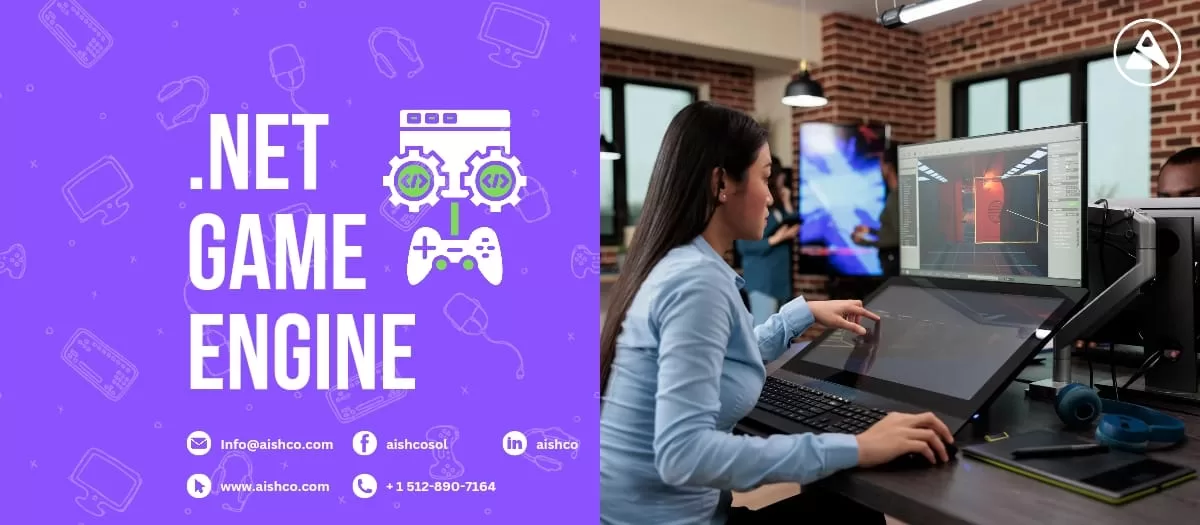Share post on
The .NET 8 game engine is gaining popularity as a versatile and high-performance tool for game developers. Offering new features, optimizations, and support for various platforms, it is an excellent choice for building everything from simple 2D games to complex 3D environments. This article explores the core capabilities of the .NET 8 game engine, why developers are adopting it for their projects, and highlights similar platforms that also serve as viable options for game development.
Key Features of .NET 8 Game Engine
Here are the most prominent features that set the .NET 8 game engine apart:
Improved Performance and Speed
Optimized for better memory management and threading, ensuring smoother gameplay.
Cross-Platform Support
Advanced 3D Rendering & Physics
Create realistic environments using integrated rendering pipelines and physics engines.
Robust Debugging Tools
Enhanced error tracking and real-time feedback streamline the development process.
Graphics API Integration
AI & Machine Learning Integration:
Similar Platforms to .NET 8 Game Engine
While the .NET 8 game engine is a powerful tool for game development, several other platforms offer unique strengths and features that cater to different types of projects. Below are some platforms that, like .NET 8, provide robust environments for building immersive games.
| Platform | Description | Key Features |
|---|---|---|
| Unity | One of the most popular game development platforms, Unity is known for its ease of use and wide community support. It is especially well-suited for indie developers and mobile games. | Strong community support, cross-platform compatibility, ease of use. Learn more about Unity |
| Unreal Engine | Unreal Engine is widely regarded for its photorealistic graphics capabilities. It is often used in AAA game development, particularly for 3D games with high graphical fidelity. | Advanced 3D rendering, photorealistic visuals, excellent for large-scale projects. Discover Unreal Engine |
| CryEngine | Known for its powerful rendering capabilities, CryEngine is commonly used in games with realistic environments and high-end graphics. It is particularly favored for FPS games. | High-end 3D graphics, powerful rendering engine, ideal for visually stunning games. Explore CryEngine |
| Amazon Lumberyard | Built on the CryEngine framework, Amazon Lumberyard offers deep integration with AWS services, allowing for seamless cloud-based game development. It is geared towards multiplayer games. | Cloud integration, multiplayer game development tools, high-quality 3D graphics. Learn about Amazon Lumberyard |
Use Cases of .NET 8 Game Engine
The .NET 8 game engine is ideal for a wide variety of game genres. Below are some popular use cases along with detailed examples of how developers have utilized the engine’s features:
2D Platformers
- Example: A retro-style 2D platformer where players navigate through levels filled with obstacles and enemies.
- Challenges: The development team needed to optimize sprite rendering and memory usage to ensure smooth performance on different devices.
- Solutions: By utilizing the improved memory management of the .NET 8 engine, the team implemented object pooling techniques that reduced loading times and minimized memory spikes, resulting in a smoother gameplay experience even during intense action sequences.
3D Open-World Games
- Example: A vast open-world game that lets players explore diverse environments like forests, deserts, and mountains, complete with dynamic wildlife and interactive NPCs.
- Challenges: The developers sought to create a living world with realistic physics but encountered performance issues while rendering a large number of objects simultaneously.
- Solutions: Through the advanced 3D rendering capabilities of the .NET 8 engine, the team employed occlusion culling and level of detail (LOD) techniques to manage rendering loads. These optimizations allowed the game to maintain high frame rates and provide a visually immersive experience without performance drops.
Simulation Games
- Example: A city-building simulation where players design and manage cities, complete with realistic economic and environmental systems.
- Challenges: The team needed to develop complex AI behavior for citizens, including intelligent pathfinding and decision-making algorithms.
- Solutions: The .NET 8 engine’s AI and machine learning integration allowed the developers to create smarter NPCs that adapted to player actions. This led to more engaging gameplay, where city inhabitants responded dynamically to changes, enhancing the realism of the simulation.
Multiplayer Online Games
- Example: A multiplayer online battle game that pits teams of players against each other in strategic, fast-paced matches.
- Challenges: Building a robust networking infrastructure that could handle real-time multiplayer interactions without lag was a major hurdle.
- Solutions: Leveraging the built-in networking capabilities of the .NET 8 engine, the developers established smooth connections for players across platforms. They also used cloud support for matchmaking and game state management, resulting in a seamless multiplayer experience.
Educational Games
- Example: An educational game designed to help children improve their problem-solving skills through engaging puzzles and challenges.
- Challenges: The development team aimed to make the game both fun and educational, ensuring that players remained engaged while learning.
- Solutions: The .NET 8 engine’s AI and graphics capabilities enabled the developers to create adaptive difficulty levels that responded to player performance. This kept learners engaged without overwhelming them, resulting in an effective and enjoyable learning experience.
How to Get Started with .NET 8 Game Engine
For developers looking to begin their journey with the .NET 8 game engine, follow these steps:
Install .NET 8 SDK
Choose Your IDE
Use either Visual Studio or Visual Studio Code for a customized development environment. Visual Studio offers more advanced tools, while Visual Studio Code is lightweight.
Explore the API
Familiarize yourself with the .NET 8 game engine API by exploring the documentation. Key areas to focus on include rendering, input handling, and physics.
Start a Small Project
Begin with a simple 2D or 3D game to experiment with the engine’s features before moving on to more complex projects.
Join the Community
The growing .NET 8 game engine community is a valuable resource for troubleshooting, learning, and sharing knowledge. You can engage with the community through forums like Stack Overflow or Reddit.
NET 8 Game Engine: Feature Enhancements in Detail
Here’s a deeper look at some of the standout features of the .NET 8 game engine:
| Feature | Description | Use Case Example |
|---|---|---|
| Improved Performance | Optimized memory handling and threading allow games to run faster, even on less powerful hardware. | 3D open-world games with high object count |
| Cross-Platform Support | Code once and deploy across multiple platforms without significant code changes. | Developing for both PC and mobile markets |
| AI & Machine Learning | Support for AI-driven gameplay allows for more engaging and intelligent NPC behavior. | Games with advanced AI-driven simulations |
| Graphics API Integration | Seamless integration with DirectX, OpenGL, and Vulkan for stunning 3D graphics. | High-end 3D games needing photorealistic visuals |
| Debugging Tools | Integrated debugging allows for faster issue detection and error resolution during development. | Any game with complex mechanics |
Future of .NET 8 Game Engine
Looking ahead, the .NET 8 game engine is expected to see significant advancements. Virtual and augmented reality (VR & AR) are likely to become major areas of focus, with future updates integrating tools for immersive gameplay experiences. The incorporation of more advanced AI and automation features will enable developers to create dynamic environments and smarter non-playable characters (NPCs), enhancing overall gameplay. Furthermore, performance optimization will remain a key priority, with continued improvements in memory management, ensuring the development of large-scale games that run efficiently across a wide range of devices. These enhancements will make the .NET 8 game engine even more versatile for developers in the coming years.
Conclusion
The .NET 8 game engine has brought game development within the .NET ecosystem to a new level. Its high performance, cross-platform support, and cutting-edge features like AI integration make it a strong contender in the world of game engines. Whether you’re an indie developer or part of a large studio, the .NET 8 game engine provides the tools you need to create captivating, high-performance games.
If you’re looking for a powerful and versatile engine to build your next game, the .NET 8 game engine is well worth considering. Its integration with Microsoft’s .NET ecosystem ensures that you can develop, debug, and deploy your games efficiently, regardless of platform.
Contact us today to discuss how we can bring your vision to life.
Share post on



